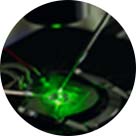The Future of Neuroscience: Toward a Connected Brain World
Background and purpose of the division
Neuroscience is undergoing rapid evolution in the 21st century. Maintaining brain health is expected to improve quality of life in aging societies, while understanding brain information processing mechanisms holds promise for groundbreaking technological innovations. As the Internet of Things (IoT) and wearable devices increasingly connect humans to digital networks—forming the Internet of Bodies (IoB)—it is not difficult to envision the next phase: the Internet of Minds (IoM), where human cognition itself becomes interconnected.
Anticipating this future, our division at Tokyo University of Science aims to establish a multidisciplinary research platform that integrates expertise in brain science, neural systems, and information technologies. We are pioneering a new academic field—Connected Neuroscience, or the Parallel Brain—to explore how multiple brains interact and synchronize in both physical and digital environments.
Research Organization and Members
Our division proposes innovative technologies for sensing and replicating biological information based on synchronized (parallel) measurements of brain activity across multiple individuals, including both mice and humans. This approach enables us to investigate the dynamics of group formation and inter-brain interactions in social contexts.
We are organized into three synergistic research groups:
Animal experiment group (mouse/human)
This group conducts multidimensional research on cognition-related brain health and disorders, including depression (characterized by pessimistic cognition), dementia (with impaired memory and cognition), and autism (involving deficits in social cognition and communication). From molecular mechanisms to neural circuits and animal models, we aim to uncover underlying processes and develop novel therapeutic and diagnostic strategies.
Sensing Group
Focusing on developmental disorders, this group analyzes gaze behavior and physiological indicators to understand personality traits and brain dysfunction. We aim to develop advanced measurement technologies and assistive devices that support both research and clinical applications.
Mathematical Model Group
This group constructs theoretical models of brain information processing systems. Drawing on data from brain imaging, cognitive psychology experiments, and brain-inspired algorithms, we aim to describe inter-brain dynamics and social cognition through mathematical frameworks.
Members and Collaboration
The division consists of 18 researchers in interdisciplinary neuroscience-related fields, including the Faculty of Science and Technology (Hiroshi Takemura, Takeo Ushijima, Takahiko Yamamoto, Akari Hagiwara, Takumi Asakura, Masataka Yamamoto), the Faculty of Pharmaceutical Sciences (Akiyoshi Saito, Daisuke Yamada), the Research Institute for Biomedical Sciences (Takeshi Nakamura, Shingo Koinuma), the Faculty of Engineering (Osamu Sakata, Takuya Hashimoto), the Faculty of Advanced Engineering (Eri Segi (Nishida), Kanzo Suzuki), the Institute of Arts and Sciences (Hiroko Ichikawa), and three visiting researchers: Ryohei Hasegawa and Toshihiro Takamatsu from the National Institute of Advanced Industrial Science and Technology (AIST) and Asami Oguro-Ando from the University of Exeter Medical School. Each member contributes unique expertise and facilities, enabling collaborative research that transcends disciplinary boundaries. This structure allows us to pursue innovative projects that would be difficult to realize in conventional research settings.
Ongoing Research Topics
We are mainly engaged in collaborative and cooperative research use of the unique talents and strengths of each member. The following is a port of list of ongoing collaborative research projects that transcend the boundaries of each specialized field, which are possible only in this division. For details, please see the division’s website.
- Elucidation of brain functions controlling social behavior (Prof. Segi and Prof. Oguro-Ando [University of Exeter])
- Investigation of cross-species vocal communication (Prof. Ichikawa, Prof. Saito, and Prof. Yamada)
- Examination of cross-species vocal communication: Relationship between ultrasonic vocalizations in mice and the effects of ultrasonic listening in humans (Prof. Ichikawa, Prof. Saito, Prof. Yamada, and Prof. Asakura)
- Analysis of Stress-Induced Depression-like State (Prof. Saito, Prof. Yamada, Prof. Takemura, and Prof. Yamamoto)
- Study on the Relationship between Human Gait Behavior and Personality Traits: Extraction and Evaluation of Gait Characteristics Derived from Human Internal State (Prof. Ichikawa, Prof. Takemura, and Prof. Yamamoto)
- Biomechanical Analysis of Age-Dependent Gait Deficiency in Cerebellar Neural Transmission Deficient Mice (Prof. Hagiwara, Prof. Takemura, and Prof. Yamamoto)
- Evaluation of the neural basis of stress sensitivity in synaptic protein-deficient mice (Prof. Hagiwara, Prof. Saito, Prof. Yamada, Prof. Takemura, and Prof. Yamamoto)
- Analysis of Jakmip1-deficient mice, a mouse model for autism (Prof. Saito, Prof. Oguro-Ando, Prof. Hagiwara, Prof. Yamada)
- DNA methylation analysis in various mouse models (Prof. Oguro-Ando, Prof. Segi, Prof. Saito, Prof. Hagiwara, Prof. Yamada)
- Examination of cross-species vocal communication: Relationship between ultrasonic vocalizations in mice and the effects of ultrasonic listening in humans (Prof. Ichikawa, Prof. Saitoh, Prof. Yamada and Prof. Asakura)
- Unveiling Emotional Resonance in Classical Music Through Brainwave Analysis (Prof. Asakura, and Prof. Hasegawa)
- Research on Causality Analysis Technology Between Various Biological Signals for Visualization of Brain-Gut Correlation Phenomenon (Prof. Sakata)
Toward Future Advancement
Our division continues to evolve by integrating collaborative and individual research efforts. We aim to further develop the field of “Parallel Brain” through interdisciplinary synergy, and by strengthening ties with clinical institutions such as medical schools and hospitals. In doing so, we will enhance the university’s neuroscience research infrastructure and actively contribute to the education and training of the next generation of researchers.










